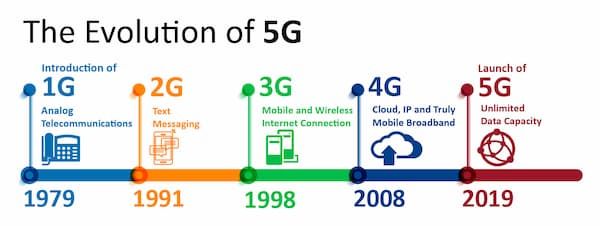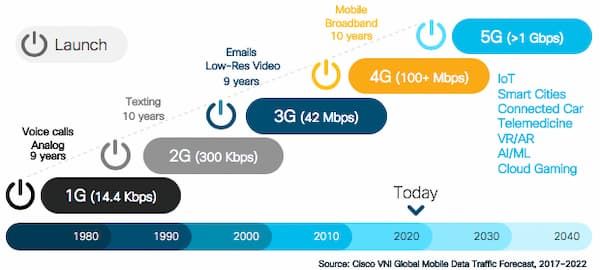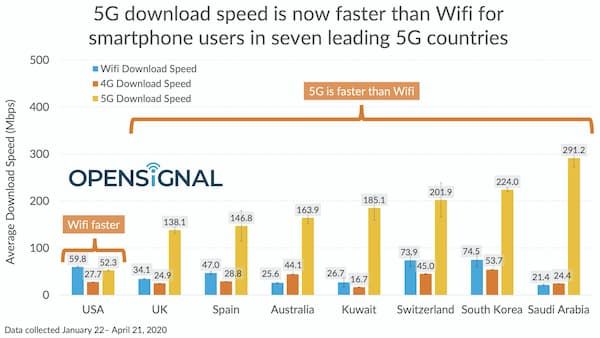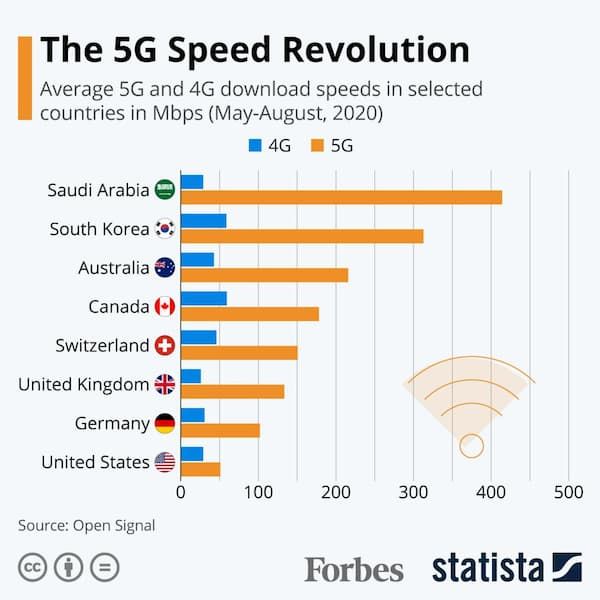1G, 2G, 3G, and 4G all led to 5G (Everything you Need to Know)
-

With the recently concluded India Mobile Congress, there has been a widespread talk over 5G. The IMC 2020 is the foremost platform for telecommunications. The 3-day conference served as a platform for India’s start-up and technology ecosystem.
Though there were many such international forums and exhibitions before this the IMC 2020 grabbed maximum attention. The reason behind this is the 5G announcement from India’s richest person Mukesh Ambani. His company Reliance Jio Infocomm is ready to bring 5G network to India in 2021.
Though Bharti Airtel’s chairman Sunil Bharti Mittal is of the opinion that India would take another 2-3 years to get 5G-ready, the new wireless network technology has gained momentum.
In this context, it is worth considering to know the different generations and terminology used in the present and past wireless network technologies.
1G (First Generation of Wireless Cellular Technology):
Launched in 1979, the IG refers to the first generation of wireless cellular technology. It was used for voice communication. The 1G delivered analog voice and thus there was no data transmission.
2G (Second-Generation Cellular Network):
Launched in Finland in 1991, the 2G networks are digital. It provided both voice and data communication services. With General Packet Radio Service (better known as GPRS), 2G offers a theoretical maximum transfer speed of 40 kilobits per second (kbit/s).
However, the EDGE (Enhanced Data Rates for GSM Evolution), there is a theoretical maximum transfer speed of 384 kbit/s.
Though many parts of the world are shutting down 2G services, Indian population especially in rural areas is still dependent on them. It has been reported that close to 300 million still use 2G mobile networks in the Indian subcontinent.
Bharti Airtel, the second-largest carrier in India, shut down their 3G network. while they have no plans to shut down 2G services. The US-based Verizon plans to shut down their 2G and 3G CDMA-based network by 31 December 2020.
Terminating 2G services could leave vulnerable people who rely on 2G infrastructure without means to access emergency contacts, leading to preventable deaths.

3G, Short for Third Generation:
Though the first commercial 3G network was introduced by NTT DoCoMo in Japan in 2001, India adopted a bit later. On 11 December 2008, the first 3G mobile and internet services were launched by MTNL in Delhi and Mumbai metropolitan cities.
Later on, the BSNL started deploying the 3G networks all over the country. Technically, the 3G is the upgrade for 2.5G GPRS and 2.75G EDGE networks for providing faster data transfer.
Thus, the term “mobile broadband” got introduced as it facilitated faster internet browsing. Though one could watch videos and stream music, it was not hassle-free and involved a lot of buffering.
The 3G downlink data speeds defined by telecom service providers varied depending on the underlying technology deployed.
They are as follows:
• up to 384kbit/s for WCDMA
• up to 7.2Mbit/sec for HSPA
• up to 21.6 Mbit/s for HSPA+In the Indian market, Bharti Airtel and Vodafone Idea has already started shutdown of the entire 3G network in many parts of the nation. However, the state-run telecom BSNL operates 3G services across the nation since it doesn’t have a 4G spectrum.
4G, The Fourth Generation of Broadband Cellular Network Technology:
The 4G system relies on all-Internet Protocol (IP) based communication such as IP telephony instead of the traditional circuit-switched telephony service. Along with IP telephony, the 4G has got its footprint in HD TV streamed multimedia, video conferencing, 3D television, and gaming services.
Data speeds of LTE-Advanced
- Peak download 1000 Mbit/s
- Peak upload 500 Mbit/s
The world’s first Long Term Evolution (LTE) branded as 4G service was opened to the public in Stockholm (Sweden) and Oslo (Norway) on 14 December 2009. However, it came to India in 2012.
Bharti Airtel became the first company in India to offer 4G services. On 10 April 2012, it started offering 4G through dongles and modems using TD-LTE technology in Kolkata. Later on, Airtel 4G was launched on mobile from February 2014 in Bengaluru.
The entry of Reliance Jio on 5th September 2016 changed the whole telecom industry and gave it a new shape. Jio is India’s only pure-play 4G network provider across all 22 telecom circles.
Within 3 years, it became the largest mobile network operator in India and eventually became the third-largest operator in the world with over 405.6 million subscribers.
5G Wireless Technology:
It’s important to note that 1G, 2G, 3G, and 4G all led to 5G, which is designed to provide more connectivity than was ever available before.
The latest 5G is the fifth generation of cellular networks. It enables a new kind of network that is designed to connect virtually everyone and everything together including machines, objects, and devices without lag.
Speed-wise, the 5G is faster than 4G. It can deliver up to 20 Gigabits-per-second (Gbps) peak data rates and 100+ Megabits-per-second (Mbps) average data rates. As of July 3, 2019, mmWave had a top speed of 1.8 Gbit/s on AT&T’s 5G network.

The Future of 5G:
Apart from just downloading a full-length HD movie in seconds, 5G is much significant than thought. It connects things virtually everywhere without lag. Thus, people can measure, understand and manage things in real-time.
The global operators have started launching new 5G networks in early 2019. As of now, 5G has been deployed in 35+ countries and counting.
Reliance Jio’s dream of a 2G-free India is a nightmare for the telcos. In the recently concluded India Mobile Congress 2020, Mr Mukesh Ambani advocated that the GoI needs to take necessary policy steps to make 2G a part of history.
He reiterated that there’s an urgent need to accelerate the migration of 350 million Indian who currently use a 2G phone to an affordable smartphone. If it happens, Jio would be the sole company to be benefitted and eventually impact the other incumbent operators including Airtel, Vodafone Idea (Vi) and BSNL-MTNL.
Prepare for the 2G/3G Sunset:

If 2G network is shut down, what will happen to Airtel’s 130 million 2G subscribers and Vi’s 60% 2G/3G subscriber base? Leave the financial challenges aside, are the Indian telecom networks ready to support 350 million additional data customers?
Instead, the Government along with network companies should formulate a phased approach to migrate the 2G users and close 2G.
There are several new 5G compatible handsets supporting the 5G network are available. For example, the first-ever all-5G smartphone Samsung Galaxy S10 5G was announced on 4 March 2019.
Recently, Apple too released the iPhone 12 and the iPhone 12 Pro, the first line of Apple phones to support 5G connectivity. But a lot has to be done to make 5G technology affordable.
Do you agree with my opinion? Share your thoughts.
You May Also Like: OPPO F17 Pro Sports Ultra Sleek Design with 8GB RAM (Priced at ₹22990)